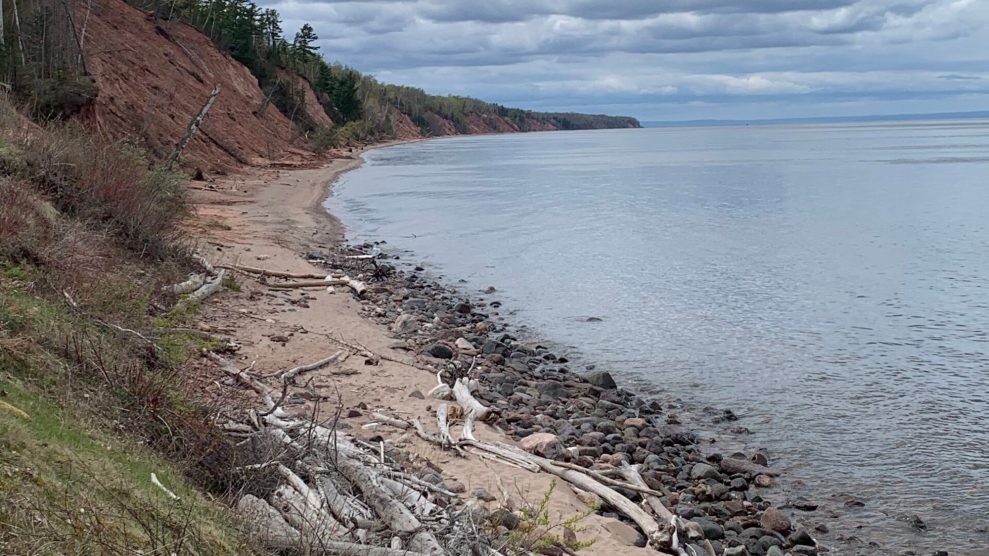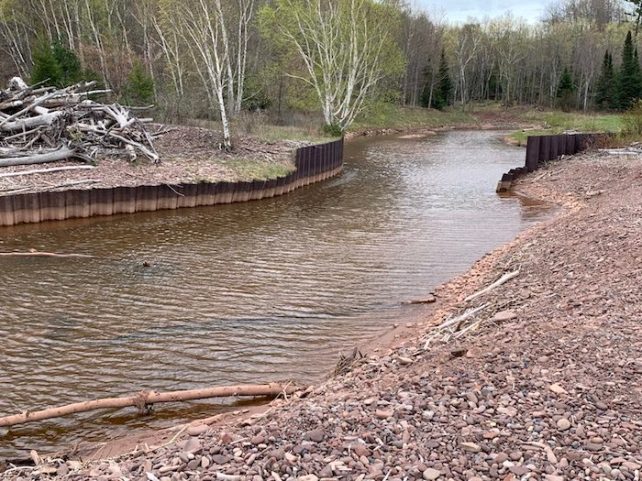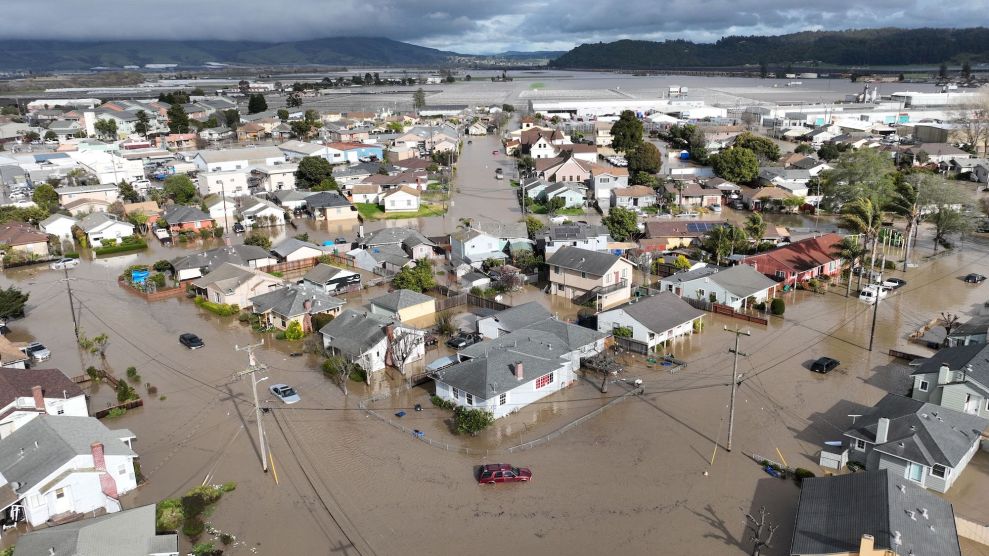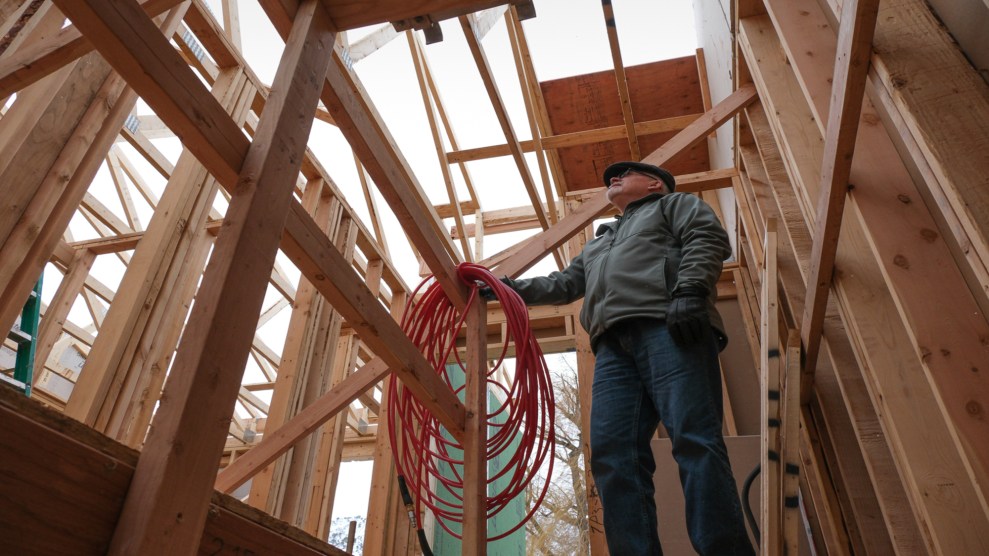
Strong storms often lead to bluff erosion on the shores of Lake Superior. Juli Beth Hinds
This story was originally published by Inside Climate News and is reproduced here as part of the Climate Desk collaboration.
Northern Wisconsin’s landscape is defined as much by the stunning shores of Lake Superior or the Bad River as the region’s seemingly endless winters. But as climate change accelerates, attention is shifting to ways of controlling a steep increase in stormwater, which means doubling down on existing management practices and turning to nature for inspiration.
Nature-based solutions involve strategies like restoring streams degraded by intense logging activity, installing rain gardens next to parking lots and buildings to absorb moisture, and bringing back wetlands to purify and protect shorelines. Such efforts not only help mitigate the effects of climate change but can also create new jobs.
Yet even when local governments, nonprofit groups and Indigenous tribes can drum up the funding to take on these projects, they are stymied by a major obstacle: People who can do the work can’t find a place to live.
“Housing!” the planning expert Juli Beth Hinds yelled recently in her kitchen while watching a PBS NewsHour television segment on Living Breakwaters, a coastal resilience project in Staten Island.
The veteran NewsHour journalist Jeffery Brown had just asked Kate Orff, a renowned landscape architect, why more people weren’t putting similar nature-based solutions into practice across the United States. Orff pointed out some of the obstacles, like deciding which jurisdiction controls what, in mapping out large-scale projects that cross boundaries.
But Hinds, who works on land-use and water-resource policy, knows that housing can be an equally important piece of the puzzle. All too often, she said, planners cannot hire people for nature-based projects when affordable places to rent or buy are scarce to nonexistent.
“We have a housing crisis,” Hinds said. “But we have not unpacked this as really a critical issue in whether, and how, we’re going to begin implementing nature-based solutions at scale.” Based on her experience and conversations with colleagues, she adds, the problem is impeding projects elsewhere in the Midwest and on the East Coast as well.
In March, the statewide research and outreach group Wisconsin Sea Grant released a report on the workforce barriers to launching more nature-based solutions in northern Wisconsin, which has experienced more flooding, higher lake levels, and more intense winter storms in recent years.
For the study, Hinds and her colleague Linda Reid interviewed stakeholders across four northern Wisconsin counties, from tribal representatives to county conservationists to environmental nonprofits. Housing came up in every interview, they said.
“I thought we’re gonna go up there and we’re gonna hear what kind of classes they need, or what audiences need the education,” said Reid, a consultant who works on climate resilience and water quality issues around the Great Lakes region. “And we get up there, and we find there’s a few things they need to learn, but for the most part, that is not the issue.”
Northern Wisconsin has a long history of involvement in sustainability and environmental stewardship. Reid notes that the Red Cliff Band and the Bad River Band of Lake Superior Chippewa were tending to the earth and waterways long before white settlers arrived in the 17th century and are highly invested in maintaining them. The region is also home to some of the first eco-municipalities in the United States, meaning that local governments have enshrined sustainability in their charters.
When Reid and Hinds arrived in April 2022 for four months of research, a large number of nature-based projects were already underway, like capturing or rerouting stormwater and snowmelt next to parking lots and buildings in the city of Superior and restoring streams in Iron County.

A devastating storm hit Iron County’s Saxon Harbor in 2016 leading to massive infrastructure damage. Stream and coastline restoration in the area improves coastal resilience.
Juli Beth Hinds
Excessive clear-cutting by the logging industry around the turn of the 20th century destabilized local streams by overloading them with sediment, a problem that continues to this day and creates a vast number of opportunities for stream restoration. Wetland restoration projects help draw wildlife back to their original habitats and improve water quality.
Many local governments are also working on surveying and on replacing culverts that cannot handle the increasing runoff from heavier rainfall, although such work is not considered a nature-based strategy. A robust network of nonprofit organizations are similarly involved in restoring wetlands, monitoring water quality and educating the public on remediation efforts. Northland College, an environmentally focused liberal arts college in Ashland, contributes knowledge and expertise as well.
While these projects could always benefit from more funding, local governments and nonprofit organizations can for the most part cobble together enough grants to get started. The communities are well versed in nature-based practices, and many local contractors are experienced in executing them. But to invest in more of these infrastructure changes, planners need people to fill salaried and hourly-wage jobs, with the work ranging from removing invasive plants to installing rain gardens.
“We have all of these jobs unfilled, and it’s all about housing,” Hinds said. “And then we start to peel the onion one more layer. What’s going on with housing? We’ve lost an enormous share of the rental market to Airbnb and Vrbo.”
After the COVID-19 pandemic took hold in the United States in the spring of 2020, prompting city dwellers to flee dense neighborhoods in search of open spaces and fresh air, the number of property owners turning dwellings into AirBnB rentals in northern Wisconsin soared, said Kelly Westlund, the housing educator for Bayfield County at the University of Wisconsin-Madison Extension.
Westlund describes the region as “a rural recreation gateway community” with abundant outdoor opportunities and beautiful scenery. Units that were once rented by locals and by people arriving after accepting jobs are now offered as vacation homes or short-term rentals.
A search of Airbnbs in Bayfield County yields options ranging from a yurt overlooking Lake Superior for $75 a night to apartments and cabins costing $200 to $300 a night. By contrast, census data shows that the county’s median monthly rent is $767. Westlund says that 44 percent of Bayfield County’s housing stock is currently considered “unoccupied,” a category that applies to seasonal vacation homes and short-term rentals that sit empty in the off season or for most of the year.
“Over the course of COVID, the Airbnb situation has just absolutely exploded,” she said. “I can’t fault individual property owners, putting their house on the market and realizing that they could really make a bundle.”
Nile Merton, who founded a local environmental consulting firm in 2016 after graduating from Northland College, contends with the housing shortage on a regular basis. His two full-time and two part-time seasonal staff members work on a variety of environmental restoration projects throughout the region, including stormwater management, controlling the spread of invasive plants, and designing and installing rain gardens to soak up the runoff from major storms.
While it’s been difficult for his employees to find a place to live in the area, they are managing.
“Whether it’s a room in a house, studio, apartment, two-bedroom, one-bedroom, they’re just not really available,” Merton said. “My employees kind of lucked out.”
Merton said that one of his employees has to drive 45 minutes to get to work. Another rents a room, he added, but it’s expensive, at $500 a month, and he barely found it in time to start work. Although Merton found a good candidate to replace a full-time worker who just left, he added, that person is still looking for a place to live.
Merton’s company, Bay Area Environmental Consulting in Washburn, is still able to take on all the restoration work he wants to accept, he said, but when it is short-staffed, he has to put off pressing management tasks for muscular work in the field.
Westlund said the housing challenges in northern Wisconsin are mirrored elsewhere in the country, with not enough homes being built and the cost of construction materials soaring in recent years.
Even when it’s available, much of the housing in northern Wisconsin is old and in need of renovation and weatherization. Given the local income statistics—the four northern counties combined have a median household income of $59,253—and the low population density, developers aren’t keen on investing in the area.
Because of the housing challenges, a variety of jobs that involve environmental restoration and stewardship sit open for years at a time. The report noted that the Bad River Tribal Government in Ashland offered a job to a qualified attorney who was eager to move back to the area but then backed out after she failed to find housing.
Sara Hudson has lived in Ashland for 20 years and works as its parks and recreation director. Part of her role involves managing the city’s four public beaches, which have frequently been shut down because of high levels of E. coli from bird droppings and, occasionally, human sewage. That led her to investigate and champion green infrastructure that helps protect water quality.
For the past three years, the city has been trying to hire an engineer. Every time it finds a promising candidate, “they look at how much a house costs and they’re like, ‘Oh my, really?’” Hudson said.
As of last month, the median price for a home in Ashland County was $152,000. But the Sea Grant report said that houses often require extensive renovation to meet “basic contemporary standards.”
For three years, Ashland’s public works director, John Butler, therefore doubled as a city engineer. “You don’t have time for everything,” Butler said, “and some things have to drop.” Among those things were maintaining and improving Ashland’s stormwater infrastructure.
Finally the city found a candidate to take the job, and because he knew a family member who was moving out of the area, he was able to secure housing.
Alex Faber, executive director of the Superior Rivers Watershed Association, an environmental nonprofit, said she has watched colleagues from partner organizations struggle with staffing as a result of the housing crunch. The region has talented people who know how to plan nature-based restoration projects, but not enough workers to execute them. While this has not affected her organization, Faber said, it tempers how she deals with various partner groups.
“A lot of my time is spent navigating, like, ‘Can I call up this person and ask them for help?’” before realizing, “‘Oh, no, they’re probably pretty overwhelmed right now because they’re trying to fill three different jobs.’” she said. “They still haven’t filled that job that’s been open for a year because nobody can move here because there’s nowhere to move to.”
Hinds said she had run into housing shortages in projects she has worked on in Vermont as well as in Wisconsin and Michigan. She encourages environmental organizers to embrace the notion that housing, and even broader development, are necessary for promoting climate resilience in communities.
And Reid, who consults on climate and sustainability efforts in Ireland as well as in the US, emphasized that the housing problem is global.
In the United States, she suggests, the people most affected by the housing crisis could profit the most from green infrastructure—either by being hired to work on such projects or by benefiting from climate remediation in their long-neglected neighborhoods.
“That lower socioeconomic and middle socioeconomic group that could, and should, be capable of making the improvements,” Reid said, “is probably going to be most likely to be harshly affected if the improvements aren’t made.”















